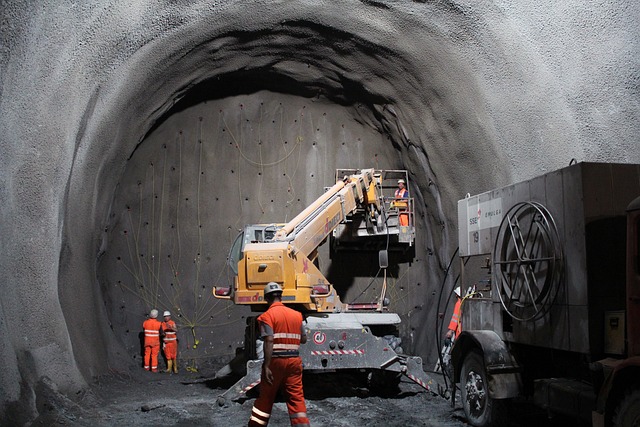Vacuum excavation services are transforming infrastructure projects by providing safe, non-destructive methods for identifying and accessing buried utilities. Using advanced techniques like hydro vacuum excavation, professionals can accurately map gas, water, electric, and telecom lines without damaging existing infrastructure. This method enhances project planning, minimizes worker risks, prevents costly accidents, and reduces service interruptions, ultimately saving time and money. Vacuum excavation contractors play a crucial role in promoting best practices for safe digging and efficient underground utility excavation.
In today’s world, safely navigating complex underground infrastructure is paramount for successful construction projects. This is where vacuum excavation services prove indispensable. By employing non-destructive excavation techniques like hydro vacuum excavation, contractors can accurately map and expose underground utilities, ensuring safe digging and minimizing disruptions.
This article explores the critical role of professional vacuum excavation in infrastructure development, delving into best practices, benefits, and the fundamental importance of safe utility exposure.
Understanding Utility Exposure: The Foundation for Safe Infrastructure Projects
Understanding Utility Exposure is paramount for ensuring the safety and success of infrastructure projects. Before breaking ground, identifying and mapping out underground utilities is crucial. This process involves utilizing advanced non-destructive excavation techniques like hydro vacuum excavation, which safely reveals the location and depth of buried lines – gas, water, electric, telecom – without damaging them.
By employing professional vacuum excavation services, contractors can accurately determine what lies beneath, facilitating precise planning for project execution. This method, known as soft dig services, minimizes risk to both workers and existing infrastructure, preventing costly accidents and service interruptions during construction. Vacuum excavation contractors play a vital role in ensuring that infrastructure projects are carried out with minimal impact and maximum safety.
Vacuum Excavation Techniques: A Non-Destructive Approach to Underground Utility Location
Vacuum excavation techniques have emerged as a revolutionary non-destructive approach to locating and exposing underground utilities. This method involves using powerful vacuum systems to carefully extract soil without damaging critical infrastructure. By employing hydro vacuum excavation, professionals can safely reveal pipes, cables, and other utilities, enabling precise planning and installation for new projects or maintenance work.
As a preferred alternative to traditional excavation methods, professional vacuum excavation services offer numerous benefits. They ensure safe digging practices, minimizing the risk of striking hidden utilities, and thus preventing costly damage and service disruptions. Vacuum excavation contractors are well-equipped with specialized equipment and expertise to handle various underground utility excavation needs, making them an indispensable asset for infrastructure projects demanding meticulous precision.
Benefits of Professional Vacuum Excavation Services in Infrastructure Development
Vacuum excavation services offer a multitude of benefits for infrastructure development projects, especially when it comes to precise and safe underground utility exposure. Unlike traditional mechanical excavation methods, professional vacuum excavation techniques employ high-pressure water and a powerful vacuum to efficiently remove soil and debris from around buried utilities. This non-destructive excavation method allows for the careful exposure of pipes, cables, and other critical infrastructure without damaging delicate underground assets.
By utilizing hydro vacuum excavation, project managers can ensure safe digging services that minimize disruptions and risks associated with traditional methods. Vacuum excavation contractors are equipped with specialized equipment to perform soft dig services, enabling them to accurately locate and map utilities before construction begins. This proactive approach not only streamlines infrastructure projects but also enhances overall safety by preventing accidental damage to underground utilities, thereby reducing costs and project delays.
Ensuring Safety and Efficiency: Best Practices for Underground Utility Excavation Contractors
Ensuring Safety and Efficiency in Underground Utility Excavation is paramount to prevent damage to critical infrastructure and ensure the safety of workers. Professional vacuum excavation contractors utilize cutting-edge technologies like hydro vacuum excavation, also known as soft dig services, to expose underground utilities non-destructively. This method allows for precise location and identification of buried lines, pipes, and cables, reducing the risk of accidental damage during excavation projects.
Best practices for safe digging services include stringent pre-planning, thorough site assessments, and adherence to industry standards. Vacuum excavation contractors employ skilled professionals who are trained in operating specialized equipment like vacuum excavation services, ensuring minimal disruption to surrounding areas. By prioritizing non-destructive excavation techniques, these experts can efficiently uncover underground utilities while maintaining a high level of safety, thereby streamlining infrastructure projects and promoting long-term operational resilience.
Infrastructure projects require meticulous planning and safe execution, especially when dealing with critical underground utilities. By understanding utility exposure and employing advanced techniques like vacuum excavation, project managers can ensure precise and non-destructive locating of utilities. Professional vacuum excavation services offer numerous benefits, including increased safety, reduced damage risks, and efficient project completion. Adhering to best practices and engaging reputable vacuum excavation contractors guarantees a successful, safe, and environmentally sound underground utility excavation process.
